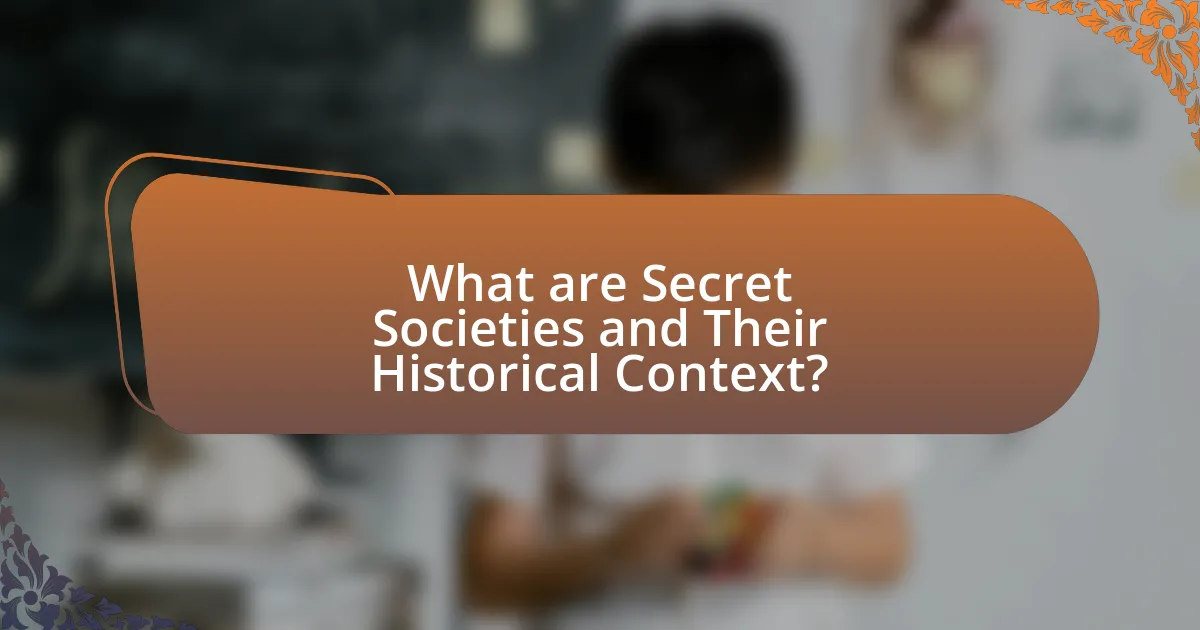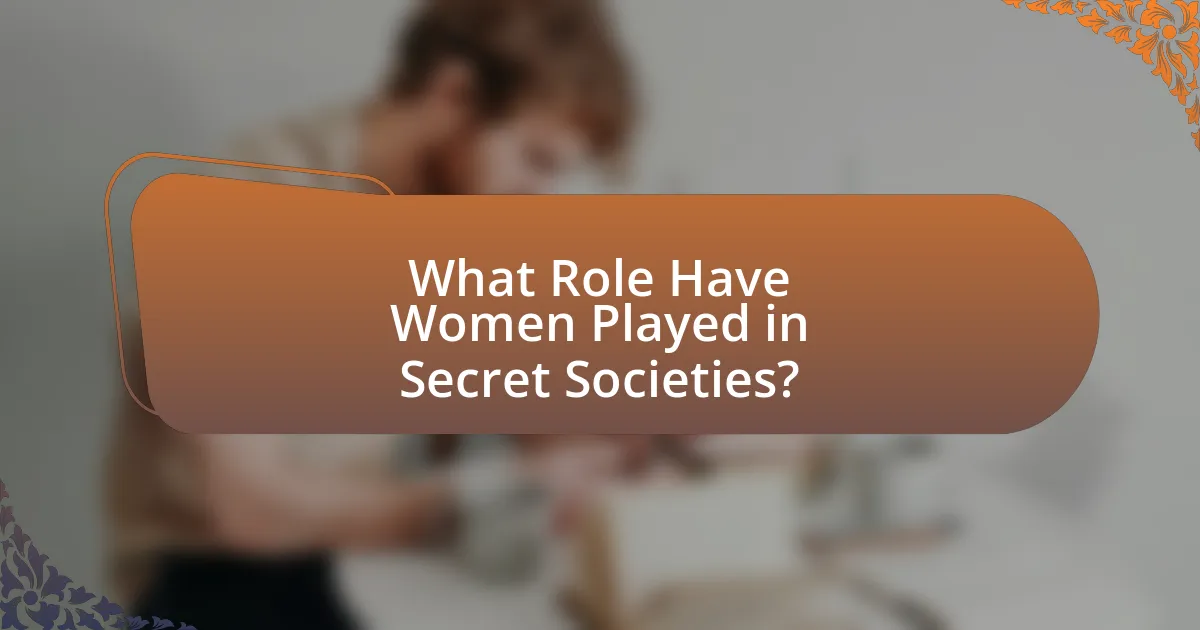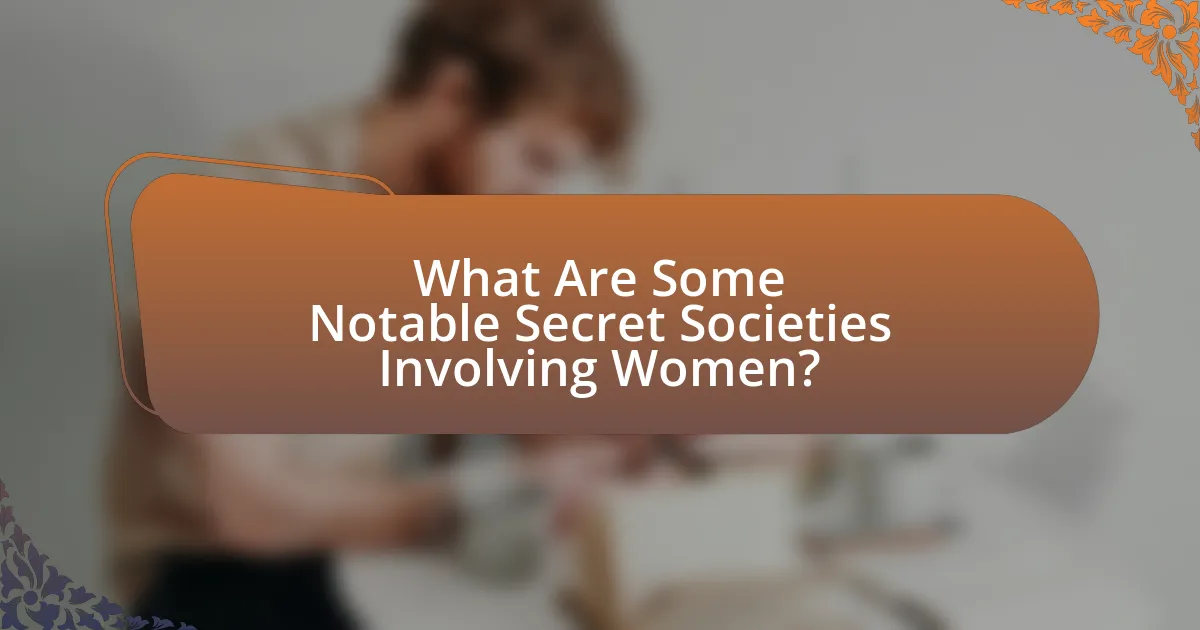The article examines the historical context and evolution of secret societies, with a particular focus on the roles and contributions of women within these organizations. It outlines the origins of secret societies, such as the Eleusinian Mysteries and the Freemasons, and discusses how societal norms influenced their formation and membership dynamics. The article highlights significant events that marked the inclusion of women in these groups, the barriers they faced, and the impact of their participation on social change and women’s rights. Additionally, it addresses the often-overlooked contributions of women in secret societies and suggests methods for uncovering their hidden history through archival research and interdisciplinary studies.

What are Secret Societies and Their Historical Context?
Secret societies are organizations that operate in secrecy, often with exclusive membership and hidden agendas. Historically, these societies have emerged in various cultures, serving purposes such as political influence, social networking, and the preservation of esoteric knowledge. For example, the Freemasons, founded in the late 16th to early 17th century, aimed to promote moral and ethical development among its members while maintaining secrecy about its rituals and teachings. Similarly, the Illuminati, established in 1776, sought to promote Enlightenment ideals but was disbanded due to its controversial influence. The historical context of secret societies often reflects societal tensions, such as the struggle for power, the quest for knowledge, and the desire for social change, making them significant in understanding cultural and political dynamics throughout history.
How have secret societies evolved over time?
Secret societies have evolved from ancient, exclusive groups focused on religious or philosophical teachings to modern organizations that often emphasize social networking and political influence. Historically, early secret societies, such as the Eleusinian Mysteries in ancient Greece, were centered around esoteric knowledge and initiation rituals. Over time, particularly during the Enlightenment, societies like the Freemasons emerged, promoting ideals of fraternity, liberty, and equality, while also allowing for broader membership beyond elite circles. In the 19th and 20th centuries, the inclusion of women in secret societies began to gain traction, leading to the formation of female-specific organizations and mixed-gender groups, reflecting changing societal norms regarding gender roles. This evolution illustrates a shift from exclusivity based on gender and class to a more inclusive approach, allowing diverse participation and addressing contemporary social issues.
What were the earliest known secret societies?
The earliest known secret societies include the Eleusinian Mysteries of ancient Greece, which date back to around 1500 BCE, and the Pythagorean Brotherhood, established in the 6th century BCE. The Eleusinian Mysteries were religious rites held in honor of Demeter and Persephone, shrouded in secrecy and accessible only to initiates. The Pythagorean Brotherhood, founded by the philosopher Pythagoras, emphasized esoteric knowledge and communal living, with strict rules and teachings that were kept confidential among its members. These societies laid the groundwork for later secret organizations by establishing the practice of exclusive membership and hidden knowledge.
How did societal norms influence the formation of secret societies?
Societal norms significantly influenced the formation of secret societies by creating environments where marginalized groups sought refuge and empowerment. In historical contexts, such as the 18th and 19th centuries, women faced restrictions in public life and limited access to education and political participation. This exclusion prompted the establishment of secret societies, where women could gather, share ideas, and advocate for their rights away from societal scrutiny. For instance, the formation of groups like the Order of the Eastern Star in the mid-19th century provided women with leadership roles and a platform for activism, reflecting a response to the prevailing norms that limited their societal roles.
Why are secret societies often shrouded in mystery?
Secret societies are often shrouded in mystery due to their exclusive membership, secretive rituals, and the deliberate withholding of information from the public. This secrecy is often a means of preserving power and influence, as seen in historical examples like the Freemasons and the Illuminati, where members engaged in clandestine activities to protect their interests and maintain control over societal narratives. Additionally, the allure of mystery surrounding these groups can enhance their appeal, leading to speculation and conspiracy theories that further obscure their true nature and activities.
What role does secrecy play in the function of these societies?
Secrecy serves as a fundamental mechanism for maintaining the integrity and exclusivity of women in secret societies. This confidentiality fosters a sense of trust and solidarity among members, allowing them to share experiences and knowledge without external scrutiny. Historical examples, such as the women’s auxiliary groups in the Freemasons, illustrate how secrecy enabled women to participate in social and political discourse while circumventing societal restrictions. Additionally, secrecy protects the rituals and teachings unique to these societies, ensuring that their cultural heritage is preserved and transmitted only among initiated members.
How does the perception of secrecy affect public interest?
The perception of secrecy significantly diminishes public interest by fostering suspicion and distrust. When organizations or groups, such as secret societies, operate behind closed doors, the lack of transparency can lead to speculation about their motives and activities. For instance, historical examples like the Freemasons have often been scrutinized due to their secretive nature, resulting in public intrigue but also skepticism regarding their influence on societal matters. This duality illustrates that while secrecy can generate curiosity, it ultimately undermines trust, which is essential for sustained public engagement and interest.

What Role Have Women Played in Secret Societies?
Women have played significant roles in secret societies, often as influential members who contributed to the development and operations of these groups. Historically, women have been involved in various secret societies, such as the Freemasons and the Rosicrucians, where they participated in rituals, decision-making, and the dissemination of knowledge. For instance, in the 18th century, women were admitted to certain Masonic lodges, and organizations like the Order of the Eastern Star were established to include women in Masonic traditions. Additionally, women have often served as catalysts for social change within these societies, advocating for issues such as education and women’s rights. Their involvement has been documented in various historical texts, highlighting their contributions and the impact they had on the evolution of these secretive organizations.
How have women’s roles in secret societies changed throughout history?
Women’s roles in secret societies have evolved from exclusion to inclusion and leadership over time. Historically, women were often barred from participating in many secret societies, such as the Freemasons, which were predominantly male-dominated. However, as societal norms shifted, particularly during the 19th and 20th centuries, women began to form their own secret societies, such as the Order of the Eastern Star and the Women’s Institute, which allowed them to engage in social, political, and charitable activities. By the late 20th century, some traditional secret societies started to admit women, reflecting broader changes in gender equality and women’s rights movements. This transition illustrates a significant shift from marginalization to empowerment within these organizations, highlighting women’s increasing influence and leadership roles in secretive and exclusive spaces.
What barriers did women face in joining secret societies?
Women faced significant barriers in joining secret societies, primarily due to societal norms and institutional restrictions. Historically, many secret societies were male-dominated, enforcing exclusionary practices that limited women’s participation. For instance, organizations like the Freemasons explicitly barred women from membership, citing traditions that upheld male exclusivity. Additionally, cultural perceptions of women as unsuitable for leadership roles further reinforced these barriers, as secret societies often valued attributes associated with masculinity, such as aggression and competitiveness. The lack of formal recognition and support for women’s rights during various historical periods also contributed to their marginalization within these groups, making it difficult for women to gain access or influence within secret societies.
How did women contribute to the activities of these societies?
Women contributed significantly to the activities of secret societies by participating in rituals, influencing decision-making, and facilitating communication. Historical records indicate that women often held positions of power within these groups, such as in the case of the Women’s Freemasonry, where they engaged in charitable work and community building. Additionally, women acted as intermediaries, using their social networks to expand the reach and influence of these societies, as seen in the role of women in the early suffrage movements, which were often supported by secretive organizations. Their involvement not only shaped the internal dynamics of these societies but also impacted broader social movements, demonstrating their essential role in both the private and public spheres.
Why are women’s contributions often overlooked in the history of secret societies?
Women’s contributions are often overlooked in the history of secret societies due to systemic gender biases and the historical exclusion of women from formal power structures. Many secret societies were predominantly male-dominated, which led to the marginalization of women’s roles and achievements within these groups. For instance, while women like Eliza Farnham and others played significant roles in various movements associated with secret societies, their contributions were frequently minimized or erased from historical narratives. This pattern reflects broader societal trends where women’s involvement in influential organizations has been historically undervalued, resulting in a lack of recognition in both academic and popular discourse.
What impact has this oversight had on historical narratives?
The oversight regarding women’s roles in secret societies has significantly distorted historical narratives by omitting their contributions and experiences. This exclusion has led to a skewed understanding of social and political movements, where the achievements of women are minimized or erased, thereby reinforcing patriarchal perspectives in history. For instance, the lack of acknowledgment of women’s participation in organizations like the Freemasons or the Order of the Eastern Star has resulted in incomplete historical accounts that fail to recognize the influence women had in shaping these groups and their ideologies. Consequently, this oversight not only marginalizes women’s voices but also perpetuates a narrative that inaccurately reflects the complexities of historical events and social dynamics.
How can we uncover the hidden contributions of women in these societies?
To uncover the hidden contributions of women in secret societies, researchers can analyze historical documents, oral histories, and artifacts that highlight women’s roles and influence. For instance, examining records from organizations like the Freemasons or various fraternal orders can reveal instances where women participated in rituals or decision-making processes, often overlooked in mainstream narratives. Additionally, interdisciplinary approaches that include anthropology and gender studies can provide insights into the social dynamics and contributions of women, as seen in studies like “Women and Freemasonry: The Secret History of Women in the Craft” by L. A. H. Smith, which documents women’s involvement in these societies.

What Are Some Notable Secret Societies Involving Women?
Notable secret societies involving women include the Order of the Eastern Star, the Women’s Army Corps, and the Sorority of the Daughters of the American Revolution. The Order of the Eastern Star, established in the mid-19th century, allows both men and women to participate and is based on Masonic principles. The Women’s Army Corps, formed during World War II, provided women with military roles and was a significant step in integrating women into the armed forces. The Sorority of the Daughters of the American Revolution, founded in 1890, focuses on promoting patriotism and education among women, emphasizing their role in American history. Each of these societies has played a crucial role in advancing women’s rights and participation in various societal aspects.
Which secret societies have been known to include women members?
Several secret societies have included women members, notably the Freemasons, the Order of the Eastern Star, and the Hermetic Order of the Golden Dawn. The Freemasons, traditionally male-dominated, have established female lodges and co-ed organizations in various regions, allowing women to participate. The Order of the Eastern Star, which is affiliated with Freemasonry, explicitly includes women as members and has a significant female presence. The Hermetic Order of the Golden Dawn, a magical society founded in the late 19th century, also welcomed women, recognizing their contributions to esoteric practices. These examples illustrate that women have played roles in various secret societies throughout history.
What were the objectives of these societies?
The objectives of women in secret societies primarily included the pursuit of empowerment, social networking, and advocacy for women’s rights. These societies aimed to create safe spaces for women to discuss issues, share knowledge, and support each other in a male-dominated society. Historical evidence shows that such societies often focused on education, philanthropy, and political activism, contributing to broader movements for gender equality and social reform. For instance, organizations like the Women’s Social and Political Union in the early 20th century sought to secure voting rights for women, illustrating their commitment to societal change.
How did the inclusion of women change the dynamics of these societies?
The inclusion of women in secret societies significantly altered the dynamics of these groups by introducing diverse perspectives and fostering collaboration across gender lines. Historically, the participation of women led to the expansion of membership and the incorporation of new rituals and practices that reflected their experiences and values. For instance, in various cultures, women’s involvement in secret societies often resulted in the establishment of networks that promoted social change, such as advocating for education and rights, thereby challenging traditional gender roles. This shift not only empowered women but also transformed the overall objectives and activities of these societies, making them more inclusive and representative of broader societal needs.
What are the most significant historical events involving women in secret societies?
Significant historical events involving women in secret societies include the formation of the Women’s Freemasonry in the late 19th century, which allowed women to participate in Masonic rituals and governance. In 1888, the Order of the Eastern Star was established, enabling women to join a Masonic-affiliated organization, marking a pivotal moment in women’s inclusion in secret societies. Additionally, the founding of the Ladies’ Auxiliary of the Knights of Pythias in 1888 represented another critical event, as it provided women with a platform for social and charitable activities within a traditionally male-dominated space. These events illustrate the gradual integration of women into secret societies, challenging gender norms and expanding their roles in social and political spheres.
How did these events influence women’s rights and societal roles?
The events surrounding women’s participation in secret societies significantly advanced women’s rights and reshaped societal roles. By engaging in these clandestine groups, women challenged traditional gender norms and asserted their agency, leading to increased visibility and recognition of their contributions. For instance, the involvement of women in organizations like the Freemasons and various suffrage movements demonstrated their capability in leadership and decision-making roles, which contributed to the eventual granting of voting rights in many countries during the early 20th century. This shift not only empowered women but also laid the groundwork for future feminist movements, as it highlighted the need for equality and representation in all societal aspects.
What lessons can be learned from these historical examples?
Historical examples of women in secret societies reveal the importance of resilience and the pursuit of agency in patriarchal structures. These instances demonstrate that women have historically sought empowerment and community through clandestine networks, often challenging societal norms. For example, the involvement of women in the Freemasons during the 18th century illustrates their ability to navigate and influence male-dominated spaces, thereby asserting their presence and rights. This highlights the lesson that collective action among marginalized groups can lead to significant social change and the redefinition of gender roles.
What can we do to further explore the hidden history of women in secret societies?
To further explore the hidden history of women in secret societies, researchers can conduct comprehensive archival studies to uncover documents, letters, and records that may reveal women’s roles and contributions. Historical accounts often overlook women’s involvement, so examining primary sources from the time, such as membership lists and meeting minutes, can provide concrete evidence of their participation. For instance, the existence of female-only secret societies, like the Order of the Eastern Star, demonstrates that women have historically engaged in these networks. Additionally, interdisciplinary approaches that combine history, sociology, and gender studies can yield deeper insights into the societal impacts of these women’s contributions.
How can researchers and historians uncover more about this topic?
Researchers and historians can uncover more about women in secret societies by examining archival materials, personal letters, and membership records that may reveal women’s roles and contributions. For instance, the study of the archives of organizations like the Order of the Eastern Star or the Women’s Freemasonry can provide insights into female participation. Additionally, oral histories and interviews with descendants of members can yield personal narratives that highlight women’s experiences. Scholarly works, such as “Women and Freemasonry: A Global History” by L. A. H. Smith, also offer critical analyses and documented evidence of women’s involvement in these societies, further enriching the understanding of their hidden history.
What resources are available for those interested in this hidden history?
Resources available for those interested in the hidden history of women in secret societies include academic books, scholarly articles, and online databases. Notable books such as “The Secret History of Women in the Occult” by K. M. McGowan and “Women and the Occult” by J. M. H. McGowan provide in-depth analyses and historical context. Scholarly articles can be found in journals like “Women’s Studies International Forum” and “Journal of Feminist Studies in Religion,” which often explore the intersection of gender and secret societies. Online databases such as JSTOR and Project MUSE offer access to a wide range of research papers and publications on this topic, allowing for comprehensive exploration of the subject.
